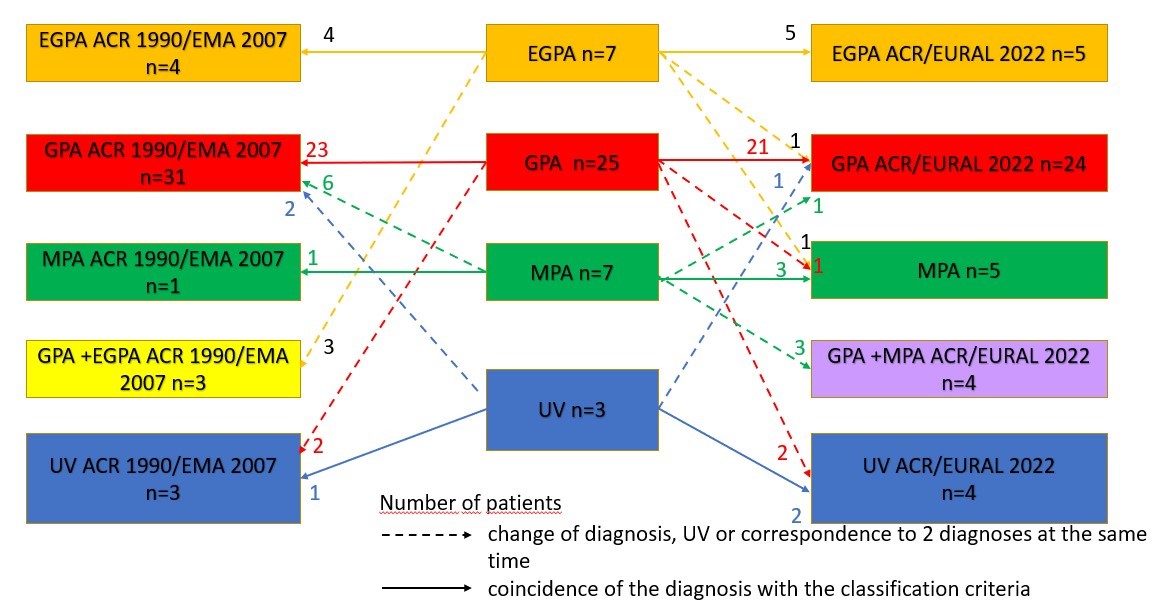Session Information
Date: Monday, November 13, 2023
Title: (1534–1553) Vasculitis – ANCA-Associated Poster II: Epidemiology, Outcomes, & Classification
Session Type: Poster Session B
Session Time: 9:00AM-11:00AM
Background/Purpose: The early diagnosis of ANCA-associated vasculitis (AAV) and treatment initiation may prevent progression to end organ damage, particularly renal disease. Based on the Vasculitis Patient-Powered Research Network study, the delay with diagnosis of AAV draws up to 7 months and 73% of patients are misdiagnosed initially. Recently the American College of Rheumatology (ACR) and European Alliance of Associations for Rheumatology (EULAR) have proposed the new classification criteria for AAV, but they have not yet validated in a different external cohort. We aimed to validate the 2022 ACR/EULAR classification criteria in a Ukrainian patients with AAV.
Methods: The retrospective study included patients diagnosed between 2010 and 2022 with Granulomatosis with Polyangiitis (GPA), Eosinophilic Granulomatosis with Polyangiitis (EGPA) and Microscopic Polyangiitis (MPA) and undifferentiated vasculitis (UV) in two expert rheumatology centers. All patients have serology confirmation (positivity of antibodies against proteinase-3 and/or myeloperoxidase performed using the ELISA test) and surrogate clinical markers of vasculitis. The 1990 ACR criteria, the 2007 European Medicine Agency (EMA) algorithm and the new ACR/EULAR 2022 criteria were applied for all patients. The level of agreement was evaluated by Cohen’s kappa coefficient with determination of sensitivity and specificity.
Results: A total of 42 patients (female: male ratio 1:0.6) diagnosed AAV with mean age at the time of diagnosis of 47.19±11.55 years were included. The distribution of AAV patients classified according to various classification criteria is shown in Fig 1. The established diagnosis simultaneously corresponded to the diagnosis according to the previous and new criteria in 28 patients, only to the ACR/EULAR 2022 criteria in 8 patients (6 MPA, 1GPA, 1 UV), to the classification criteria of ACR 1990 and the EMA algorithm in 5 patients (3 EGPA, 1 UV, 1 GPA), and one patient has not met any criteria. The ACR/EULAR 2022 classification criteria compared to the previous ones demonstrated better agreement with the established diagnosis of GPA (k 0.6 vs 0.3, sensitivity 88.0% vs 92.0%, specificity 70.6% vs 35.3 %) and MPA (k 0.5 vs 0.2, sensitivity 71.4% vs 14.3%, specificity 88.6% vs 100%) but worse agreement with the diagnosis of EGPA (k 0.8 vs 1.0, sensitivity 71.4% vs 100%, specificity 100% vs 100%).
Conclusion: The ACR/EULAR 2022 classification criteria for AAV demonstrate a good accuracy in the Ukrainian patient population (for GPA, sensitivity – 88%, specificity – 71%, for MPA – 71% and 89%, respectively, and for EGPA – 71% and 100%, respectively) and an advantage compared to the previous classification criteria for GPA and MPA. However, about 10% of the patients are still unclassified and the same amount are matched two diagnoses with the ACR/EULAR 2022 criteria.
To cite this abstract in AMA style:
Petelytska L, Kravchenko V, Iaremenko O. Validation of the 2022 American College of Rheumatology/European Alliance of Associations for Rheumatology Classification Criteria in Patients with ANCA-associated Vasculitis [abstract]. Arthritis Rheumatol. 2023; 75 (suppl 9). https://acrabstracts.org/abstract/validation-of-the-2022-american-college-of-rheumatology-european-alliance-of-associations-for-rheumatology-classification-criteria-in-patients-with-anca-associated-vasculitis-2/. Accessed .« Back to ACR Convergence 2023
ACR Meeting Abstracts - https://acrabstracts.org/abstract/validation-of-the-2022-american-college-of-rheumatology-european-alliance-of-associations-for-rheumatology-classification-criteria-in-patients-with-anca-associated-vasculitis-2/

